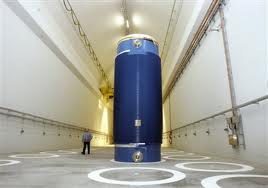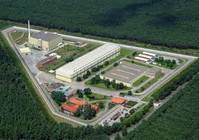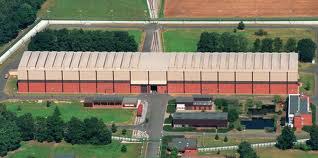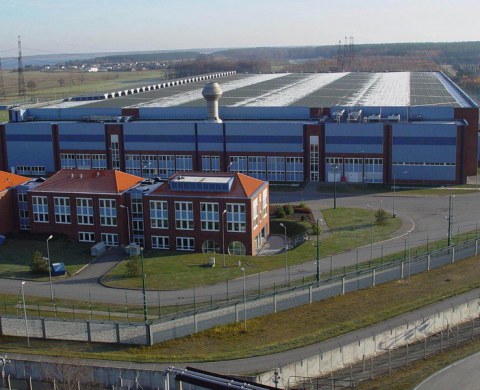By Diet Simon
Update
On Sunday (12 Dec) in classic winter weather 700 people celebrated the cancellation of nuclear waste transportation to Russia from Ahaus by forming a human chain around the temporary dump there. A new demo was called for 30 January outside a nuclear research facility in Jülich, near Cologne, from where 152 containers of waste are shortly to go to Ahaus. Also on 12 December 850 people demonstrated in Freiburg, southwest Germany, for immediate cessation of nuclear power production. There was a Franco-German summit in the town at the time.
(For the same story with links to sources see http://linksunten.indymedia.org/de/node/30620)
In Greifswald on the German Baltic Coast 3,600 people took part in an anti-nuclear rally in drizzly cold weather on Saturday. They were demonstrating against the imminent transportation of nuclear waste from France for storage in the nearby coastal resort of Lubmin.
Activists hope that many protesters will travel to the area next week to take part in rail actions against that consignment and others to follow soon.
In Freiburg, southwest Germany, there was also an anti-nuclear demonstration as French and German leaders met there for a summit.
Today, Sunday, protests will continue in Ahaus, a west German town also to receive more nuclear waste in the near future, and since 2005 storage location – among other waste - of nearly 1,000 highly radioactive spent fuel rods that were to be shipped to Mayak in Russia, the most radioactively contaminated place on the globe.
German and Russian activists have just made the German government scrap that plan.
Environment Minister Norbert Röttgen said the “harmless disposal” of the waste could not be guaranteed, claiming that the recycling plant at Mayak is not working. The plant has contaminated the Tetsha River.
Only when “harmless disposal” could be guaranteed would another licence for the transport be considered, the minister said.
Activists in Ahaus, where the waste is now in a thin-walled hall not safe from air crashes, note that he’s leaving the door open for future waste transportation to Russia “and we’ll have to stay alert”.
They dispute the minister's claim that recycling has stopped in Mayak. The Ahauseners hear from their Russian contacts of fears that German and other European waste taken there could be used to make nuclear bombs because Mayak was always a military project.
The Ahauseners also welcome as "a small step forward to ending the catastrophic conditions there" news that a Moscow court has accepted a complaint from residents against further operation of the Mayak plant.
They will collect donations at today’s demo to support the action by the Mayak litigants. (Donations account: Aktionsbündnis Münsterland gegen Atomanlagen, Volksbank Wettringen, BLZ 357 730 701, Konto 401 646 18, "Majak".
(If you understand German, you may want to watch a television report about Mayak at http://www.wdr.de/tv/monitor/sendungen/2010/1118/atom.php5 . I’ve reported on it at http://indymedia.org.au/2010/11/21/berlin-breaks-german-law-to-dump-nucl.... There’s also a film about Mayak in Russian with German or English subtitles at http://www.videowerkstatt.de/)
The waste that is/was destined for Mayak has already been on hazardous 2005 truck journeys of more than 600 autobahn kilometres from a decommissioned research reactor at Rossendorf near Dresden (90 km west of the Polish border) to Ahaus (25 km east of the Dutch border), near Münster. (Some details in English about the Ahaus facility are at http://www.oneworldweb.de/castor/ahaus/internat/english.html.)
The fuel rods, now in 18 containers, were supplied by the former Soviet Union for the experimental reactor at Rossendorf when that area was still part of communist East Germany.
Following German reunification 20 years ago, the state government of Saxony dismantled the spent fuel rods from the reactor and sent them to the Ahaus amid protest by thousands of people.
Russia had expressed its readiness to reprocess the spent fuel and store the waste at its facility under an inter-governmental agreement signed recently.
However, Russian environmental groups and scientists had warned against sending the radioactive material to Russia saying that the Mayak plant, which was one of the oldest nuclear research centres in the former Soviet Union, is very unsafe for reprocessing and storage of waste.
Russian environmental organisations and anti-nuclear activists had in a letter to Chancellor Angela Merkel, urged her not to send the fuel rods to the Mayak plant, which had a series of accidents since the 1950s.
Germany's anti-nuclear Greens party claimed that the decision to stop the nuclear shipment to Russia resulted from its campaign against the export. Greenpeace welcomed the decision and said it would have been "irresponsible" to send a nuclear transport to an "ecologically catastrophic region".
The Mayak plant was one of the centres of the ex-Soviet Union's nuclear weapons programme and it was kept secret for more than 30 years. A series of accidents in the plant led to the radioactive contamination of a large territory in the Ural region.
It is estimated that more than half a million people have been irradiated and some of them were exposed to radiation levels 20 times as high as those during the Chernobyl nuclear disaster in Ukraine.
The Ahauseners remind the anti-nuclear movement that in Jülich near Cologne 152 waste caskets are awaiting shipment to Ahaus next year. Low and medium radioactive waste from Duisburg and Jülich is still being dumped in Ahaus, although a former iron ore mine in north Germany, Schacht Konrad, earmarked as final repository, is becoming more and more of a mirage.
And in nearby Gronau, site of Germany’s only and huge uranium enrichment plant, an interim repository for uranium waste may be built next year.
“Nuclear waste can’t be got rid of. We urgently need an end to nuclear power production,” the Ahaus resistance write.
They’ve been calling for large attendance at today's (12 Dec) demonstration.
Earlier it looked likely that two nuclear waste consignments were to run through Germany simultaneously, around the middle of the month.
I would have thought the activist movement too stretched to put up much resistance to both of them.
I imagined the anti-nuclear movement out of puff after 50,000 just turned up to protest waste dumping in Gorleben, 20,000 a few weeks prior at 120 locations across the country, a few months further back 150,000 in Berlin and dribs and drabs all over the place all the time.
One of my Gorleben contacts agrees with my supposition that double-trouble was government strategy to keep protest as fragmented and hence as small as possible, but “those who can, will engage. C’est la vie”.
Mobilisation talk on the web says actions are planned in about 50 towns against a shipment from a plutonium facility in Cadarache, southern France, to Lubmin on the German Baltic coast.
Five caskets for the transportation and storage of nuclear waste (CASTORS), containing highly radioactive waste from an abandoned recycling facility near Karlsruhe in Germany, and four CASTORS from the French nuclear research centre in Cadarache are to be transported to an interim repository near Lubmin. (See more on Baltic radioactive pollution below.)
Cadarache holds waste from the former German experimental nuclear-powered experimental cargo ship, Otto Hahn, (http://en.wikipedia.org/wiki/Otto_Hahn_(ship)) originally taken there from Geesthacht in north Germany after it was deactivated in 1979.
On the Ahaus-Mayak plan, the federal government has to contend with some hiccups, through no one doubts that they’ll ultimately get their way. Various German local governments have banned the use of their ports (though I don’t see how they can sustain that), the North-Rhine Westphalian state government responsible for Ahaus doesn’t want the shipment to happen and there’s no treaty with Russia yet, though one is awaiting signature. There was also talk of a French port being used.
The spent fuel to come from France is especially dangerous, weapons-grade highly enriched uranium, which had earlier been declared as cleaning rags, medical waste and so on.
The Lubminers, who’ve just hosted a meeting by 45 north German anti-nuclear groups, say thousands are expected to also protest against the delivery to their tourism resort town.
On the day of the transport, expected to be 15 or 16 December, actions are planned throughout Germany along the route the train carrying the CASTORS to Lubmin will take. Action is being mobilised especially in such towns as Erfurt, Halle, Magdeburg, Ludwigslust, Rostock, Potsdam/Berlin and Neubrandenburg as well as at the Franco-German border near Karlsruhe.
Rail squat blockades and creative actions are planned for the last 22 kilometres of track from Greifswald to the interim depot. This is the sort of scenario the Gorlebeners are good at because their CASTORS also travel 20 kilometres by road from the railhead to the storage hall, and they’re acting as “consultants” to the locals. Encouraged by the waves of protest in recent months, the Lubmin groups say they’re preparing on a bigger scale than ever, for example in arranging sleeping places for visitors.
“We will not just stand idly by as the scandalous transport races along at a reckless 100 km per hour, as it did recently in Gorleben,” said civil engineer Bernd Ebeling. “The transport as such is already a huge safety risk.”
Physicist Wolfgang Neumann from Hanover, a nuclear expert, explained that in case of an accident with a long-burning fire (such as the explosion of a tank wagon) large amounts of radioactive particles could be released. In wind direction even 15 km away the limit of 50 millisieverts in the radiation protection regulations would be exceeded; within a radius of five kilometres the population would have to be evacuated or resettled long-term.
Lubmin – the forgotten nuclear dump
Activists opine that Lubmin is being brought into play more because it’s been a more or less out of sight, out of mind dumping location.
The town is primarily known as a seaside resort and holiday destination on the Baltic, less known for the Baltic Sea gas pipeline, solar installations, resistance against a once planned hard-coal power station, and practically unknown outside the region as a nuclear dump. Germans in general are still in the process of getting to know places in what was once the communist Germany, almost as if it had been a foreign country.
I’ve taken the following from an article by Rebecca Südmersen, Adelwin Bothe and Daniel Daedlow posted at the Lubmin activists’ site, http://lubmin-nixda.de/. I’ve translated it for them.
Next to the remnants of a former nuclear power station at nearby Greifswald, construction began in 1992 of a building with 20,000 m² floor space with eight hall sections, intended for the demolition and interim storage of nuclear wastes from power stations at Greifswald and Rheinsberg.
The pride of the operators are conditioning facilities to separate and package highly, medium and low radioactive substances. The size of the facility clearly exceeds the capacities needed for the former two power stations. Already in the early 90s allegations were raised that the storage capacity was designed for the needs of the west German nuclear industry.
The politicians of the state of Mecklenburg-West Pomerania agreed to the construction of an interim storage hall in Lubmin in 1991 on condition that only waste from east German power stations would be stored there. Since there was no precise estimate of the radioactive inventory, the actually needed size of the hall remained in the dark, however, and the then federal environment minister (now chancellor), Angela Merkel, took the position that the actually needed size of the interim repository could not be firmly established at that time.
Twenty years on, the assumption that Lubmin is also to take in nuclear waste from west German installations is being confirmed. It has become clear after 30 years of trials that the final storage of nuclear waste in salt mines such as Asse or Morsleben in Lower Saxony doesn’t work. The Asse dump at Wolfenbüttel, near Salzgitter, has the dubious honour of being the most contaminated legacy of Germany’s nuclear power industry.
Some 126,000 barrels of nuclear waste in the Asse mine threaten to contaminate the ground water and have to be retrieved in a dangerous procedure, which has yet to start. In the Lower Saxony village of Gorleben waste is still stored in a surface hall, with the federal government pushing hard to make an especially dug pit in a salt deposit the permanent repository. This although studies have found that water is penetrating into this purpose-built pit as well and that the salt contains pockets of gas, both conditions posing great dangers in case nuclear waste is deposited there.
And it’s still unclear where the waste is to be taken. One possibility to at least take it a bit out of public view and discussion would be temporary storage in Lubmin. Interim storage there has been licensed up to 2039. But since no solution to final storage is to be expected in the coming decades, the future of the waste and its keeping remains up in the air.
A nuclear power station can be operated, and produce waste, only because the operators are not required to prove harmless disposal of their waste, unlike any other enterprise. All they need is a so-called “preliminary” proof of disposal. “Preliminary” replaces disposal, which doesn’t exist and with very high likelihood will never exist. Because there is no safe disposal and no solution in sight in the foreseeable future, the logical consequence for many people is immediately to stop nuclear power production all over the world. That’s not the scenario in Germany and so more nuclear waste is to be expected, especially in Lubmin.
Beyond the storage issue as such it is suspected that the main reason Lubmin was chosen was that not much protest was expected there. As has been admitted in the case of Gorleben, politicians prefer thinly-populated locations in structurally weak areas.
Chronology of the Lubmin interim storage hall
Lubmin: c. 15 km as the crow flies east of Greifswald
Floor space of the light-construction hall: 20,000m²
Interim storage of low, medium and highly radioactive nuclear waste, currently holding 65 CASTOR caskets
Until the end of 2010 licensed for five CASTOR caskets from Karlsruhe and for four caskets from Cadarache in southern France
The five operating blocks of the nuclear power station were switched off in 1990, three others planned were not finished
1991 approval by all parties in the state parliament in Schwerin of construction of the interim repository on condition that only nuclear waste from east German power station would be stored there
1992 the governing coalition of Christian Democrats and Free Democrats prevents the decision to take in only waste from Greifswald and Rheinsberg
1993 "Redesignation" for storage of highly radioactive waste; the partial hall for highly active waste is three times as large as needed
1995 15,000 objections to the repository are filed
1999 Completion and start of operation of the entire interim repository
2006 Intake of the last CASTOR caskets from Rheinsberg and Greifswald
2007 Transportation of the reactor pressure container from the Rheinsberg power station
The Baltic is the most radioactively polluted ocean in the world. It’s more or less like a big lake, with not much water exchange with other seas; all radioactivity reaching it gets concentrated there. The biggest (historical) atomic polluters of the Baltic were the 1986 reactor catastrophe of Chernobyl, the earlier worldwide open-air nuclear bomb tests and the discharges of the nuclear facilities in Sellafield (UK).
Additionally there are the later impacts of the nuclear power plants around the Baltic seaboard. The Swedish reactors have the biggest impact to the radioactivity of the Baltic Sea, followed by the Finnish reactors and eventually by the Russian facilities. Nuclear waste, uranium and fuel element transports across the Baltic Sea are increasing the atomic risk as well as the proposed final repositories for high level radioactive waste beneath (!) the Baltic Sea in Forsmark (Sweden) and Olkiluoto (Finland). If plans for uranium mining and power plants construction projects in Scandinavia go ahead, the radioactive contamination of the Baltic will be increased even more.
Outside scientific circles, not much is known about the Baltic’s radioactivity. Some regions lack even a basic knowledge and awareness of the risks of the technology, and many people around this inland sea don’t even know certain facilities exist.
While an active anti-nuclear movement exists in Germany, the former strong movements of Denmark and Sweden have disappeared nearly completely and the establishment of new groups is progressing slowly as people are confronted with new projects of the nuclear industry. In Finland a lively new movement against the atomic projects there has grown during the last few years, working closely with and supported by international activists.
-----------
With nuclear power madness gaining traction in our own country, I'm wondering whether it would be useful if I wrote on the protest methods of the Gorleben resistance. It might coach our own activists. Two Aussie women were actually over there during a CASTOR delivery at the invitation of the Gorleben farmers to collect ideas. Let me know here what you think of that idea and I'll check "Recent postings".






Comments
Re: Enough protest puff for two simultaneous German nuclear ...
yes please Diet, more on the Gorleben protests would be great.
and one or two weblinks for those of us who want to follow the German nuclear debates if possible
also, did the German upper house of parliament recently approve the new nuclear power laws? i thought the government was avoiding putting the legislation to the upper house because it would be voted down.
thanks, jim
Yes, upper house passed the law
x
Where to site Australian nuclear power stations?
02 December 2010
MEDIA RELEASE
Nuclear power stations from
the Sunshine Coast to the Central Coast?
Proponents of a new debate about the role of nuclear power stations in Australia should start with a discussion about their location, said The Australia Institute.
"It will be interesting to see which members of parliament think that nuclear power stations should be built in their electorates, and it will be fascinating to see who volunteers their communities for the necessary nuclear waste dumps," said Executive Director Dr Richard Denniss.
West Australian Premier Colin Barnett’s recent comments are a case in point. While supporting nuclear power he has been quick to dismiss a nuclear power station being built in WA.
Following former Prime Minister John Howard’s call for a 'full-blooded' debate in 2006, The Australia Institute published a paper identifying 19 potential sites for nuclear power plants.
They were:
· In Queensland – Townsville, Mackay, Rockhampton, Gladstone, Bundaberg, Sunshine Coast and Bribie Island
· In New South Wales and the Australian Capital Territory – Port Stephens, Central Coast, Botany Bay, Port Kembla and Jervis Bay/Sussex Inlet
· In Victoria – South Gippsland, Western Port, Port Phillip and Portland
· In South Australia – Mt Gambier/Millicent, Port Adelaide and Port Augusta/Port Pirie.
"The problem with coal-fired power stations is that they generate cheap energy by pushing the environmental costs onto others. There is simply no point in discussing the cost of nuclear power unless we include all of the social and environmental costs in the analysis from the very beginning," said Dr Denniss.
A copy of The Australia Institute’s paper, Siting nuclear power plants in Australia: Where would they go? is available at www.tai.org.au
For media enquiries contact Serena Rogers on 0421 759 262
Re: Enough protest puff for two simultaneous German nuclear ...
What if Chernobyl happened in Australia? Check out the interactive map:
http://www.choosenuclearfree.net/energy/chernobyl
If they seriosuly want it, it'll breeze in
At this juncture I don’t want to think about Chernobyl. Right now I’m shit-scared by the apathy of average Australians about anything political. The smallest Greek village, where many have had just four years of school, is more politically interested and savvy than most of our mob. If the pollies and the industrialists pulling their strings really want it, nuclear power production will breeze in. Can you imagine 150,000 people travelling to Canberra to protest, or 50,000 travelling to Muckaty Station in the NT to protest against waste dumping, or 20,000 simultaneously coming out at 120 different locations? Or anti-nuclear protests happening in dribs and drabs everywhere all the time? Nah, don’t bother me, the beer’s cold, the barbie’s grilling and we’ll be off to the surf later.....